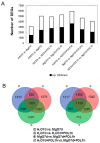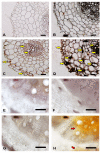Molecular Analysis of MgO Nanoparticle-Induced Immunity against Fusarium Wilt in Tomato
- PMID: 36769262
- PMCID: PMC9918173
- DOI: 10.3390/ijms24032941
Molecular Analysis of MgO Nanoparticle-Induced Immunity against Fusarium Wilt in Tomato
Abstract
Fusarium wilt, caused by Fusarium oxysporum f. sp. lycopersici (FOL), is a devastating soilborne disease in tomatoes. Magnesium oxide nanoparticles (MgO NPs) induce strong immunity against Fusarium wilt in tomatoes. However, the mechanisms underlying this immunity remain poorly understood. Comparative transcriptome analysis and microscopy of tomato roots were performed to determine the mechanism of MgO NP-induced immunity against FOL. Eight transcriptomes were prepared from tomato roots treated under eight different conditions. Differentially expressed genes were compared among the transcriptomes. The Kyoto Encyclopedia of Genes and Genomes enrichment analysis revealed that in tomato roots pretreated with MgO NPs, Rcr3 encoding apoplastic protease and RbohD encoding NADPH oxidase were upregulated when challenge-inoculated with FOL. The gene encoding glycine-rich protein 4 (SlGRP4) was chosen for further analysis. SlGRP4 was rapidly transcribed in roots pretreated with MgO NPs and inoculated with FOL. Immunomicroscopy analysis showed that SlGRP4 accumulated in the cell walls of epidermal and vascular vessel cells of roots pretreated with MgO NPs, but upon FOL inoculation, SlGRP4 further accumulated in the cell walls of cortical tissues within 48 h. The results provide new insights into the probable mechanisms of MgO NP-induced tomato immunity against Fusarium wilt.
Keywords: Fusarium oxysporum; Solanum lycopersicum; apoplast; glycine-rich protein; nanoparticles; plant defense; transcriptome.
Conflict of interest statement
The authors declare no conflict of interest.
Figures












References
-
- Hirooka T., Ishii H. Chemical control of plant diseases. J. Gen. Plant Pathol. 2013;79:390–401. doi: 10.1007/s10327-013-0470-6. - DOI
-
- OECD . Report of the OECD Workshop on Integrated Pest Management (IPM) Strategies for the Adaptation and Implementation of IPM in Agriculture, Contributing to the Sustainable Use of Pesticides and to Pesticide Risk Reduction. Organisation for Economic Co-operation and Development; Paris, France: 2014. [(accessed on 28 November 2022)]. Berlin, Germany, 16–19 October 2012. Available online: https://www.oecd-ilibrary.org/docserver/9789264221635-en.pdf?expires=166....
MeSH terms
Substances
Grants and funding
LinkOut - more resources
Full Text Sources
Miscellaneous

